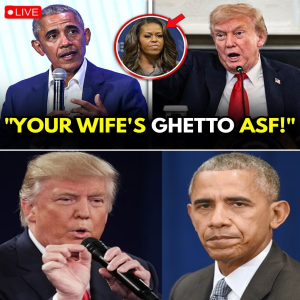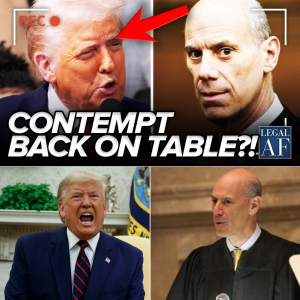A sensational headline circulating widely online this week — “Trump ERUPTS After Jimmy Kimmel Exposed Karoline Leavitt’s and His Dark Secrets on Live TV” — has reignited debates about misinformation, political satire, and the increasingly porous boundary between news and entertainment. Although no such confrontation occurred on any verified broadcast, the speed and scale of the headline’s spread underscore how rapidly dramatic narratives take hold in the digital age, especially when they involve figures already central to polarized national discourse.
The headline’s framing evokes a now-familiar dynamic: Donald J. Trump confronting a perceived adversary and a late-night host using comedy to deflate political bravado. Karoline Leavitt, a rising conservative communications figure who has frequently appeared in right-leaning media circles, also appears as part of this imagined exchange. Together, these names create a perfect recipe for viral amplification — a storyline that is emotionally engaging even in the absence of factual grounding.
A Viral Story Without a Broadcast

Media analysts note that the story’s structure fits the architecture of modern click-driven political content. It taps into heightened emotions, includes easily recognizable personalities, and promises a dramatic revelation. The use of phrases like “erupted,” “exposed,” and “dark secrets” has become a familiar tactic in online political sensationalism, often blurring the boundary between satire, speculation, and reportage.
In reality, no live television incident matching the headline’s description occurred. Neither Mr. Trump nor Ms. Leavitt appeared in a segment where Jimmy Kimmel unveiled private information or provoked an on-air emotional outburst. The narrative exists instead within a growing ecosystem of hybrid content — part entertainment, part political theater — that thrives on the social media economy of shares, sensational phrasing and rapid engagement.
The Role of Late-Night Comedy
Jimmy Kimmel, like other late-night hosts, frequently uses his platform to comment on politics, often blending humor with criticism. His monologues are designed for comedic impact, not actual investigative reporting. However, in the fragmented media landscape, late-night content often reaches audiences who treat comedic framing as a form of political analysis. Clips from Kimmel’s show — sometimes lacking context when reposted — circulate as standalone media, reshaping public perception far beyond their original comedic intent.
The headline’s virality reflects this dynamic. It suggests a dramatic escalation, a televised confrontation, and a moment of political rupture — even though no such exchange took place. Instead, it illustrates how digital audiences increasingly respond to narratives that feel plausible within the political climate, regardless of whether they occurred.
Why These Narratives Stick
Political communication scholars argue that such stories resonate because they align with existing public perceptions. For Mr. Trump’s critics, the idea of a meltdown under comedic pressure fits a narrative they already believe. For his supporters, the notion of a media figure “attacking” him or his allies reinforces longstanding concerns about bias in entertainment and journalism.
The inclusion of Ms. Leavitt, a younger and less nationally prominent conservative figure, suggests another pattern: the extension of political conflict into new personalities who appear to represent emerging factions or styles of conservative communication. Even fictionalized scenarios can elevate peripheral figures into the center of attention, reshaping how various political movements perceive themselves and their adversaries.
A Broader Reflection of Media Fragmentation

The viral spread of the headline also highlights deeper structural challenges in the American media environment. Traditional gatekeepers — network newsrooms, established newspapers, and broadcast standards — no longer control the flow of political narratives. Online platforms reward speed, emotional impact and algorithmic engagement. As a result, dramatic and provocative claims can achieve mass reach long before any fact-checking or contextual reporting catches up.
This creates a feedback loop: sensational stories travel quickly; corrections or clarifications rarely achieve the same momentum. In the meantime, audiences form opinions based not on events but on the perception of events — a shift with significant implications for political polarization and public trust.
Entertainment as Political Battleground
The intersection of late-night comedy and political identity has become particularly sharp during and after Mr. Trump’s presidency. For supporters, comedians like Kimmel are seen as hostile cultural elites. For critics, these comedians provide a counter-narrative to political messaging they view as misleading or dangerous. Even fictional scenarios depicting dramatic clashes are interpreted through these partisan lenses.
Conclusion
The headline that spread across social platforms this week may not correspond to any real broadcast, but its popularity reveals something genuine: the hunger for emotionally charged stories and the continuing collapse of boundaries between politics and performance.
In a media era shaped by speed, spectacle and the jockeying of personalities across both political and entertainment landscapes, narratives can become powerful even when they exist only in the imagination. The challenge for audiences — and for journalism — is distinguishing between the theatre of politics and the reality beneath it.





